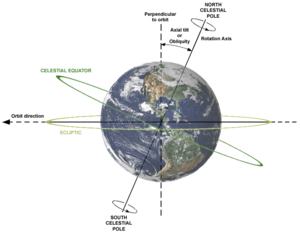Axial tilt facts for kids
In astronomy, axial tilt is the angle between a planet's spin axis and a line that is perfectly straight up from its orbit path. It's also known as axial inclination or obliquity. The Earth's axial tilt is the main reason we have seasons, like summer and winter. Without this tilt, the weather would be much the same all year round in most places.
Contents
Axial Tilt of Solar System Planets

Here are the axial tilts for different objects in our Solar System:
- Sun: 7.25 degrees (compared to the Ecliptic)
- Mercury: About 0.01 degrees
- Venus: 177.4 degrees
- Earth: 23.439281 degrees
- Moon: 1.5424 degrees
- Mars: 25.19 degrees
- Ceres: About 4 degrees
- Jupiter: 3.13 degrees
- Saturn: 26.73 degrees
- Uranus: 97.77 degrees
- Neptune: 28.32 degrees
- Pluto: 119.61 degrees
Why Venus, Uranus, and Pluto Have Big Tilts
The axial tilts of Venus, Uranus, and Pluto are very unusual. They are all greater than 90 degrees. This means their north poles point in a different direction than most other planets.
Venus's Backward Spin
Venus spins very slowly and in a backward direction. This is opposite to how planets like Earth spin. Because of this, Venus's north pole points 'down' (southward). So, the angle of its spin axis is 177.4 degrees. Scientists have different ideas why this happened. It might be because of huge impacts early in its history. Its slow spin and lack of a moon could also be related to these events.
Uranus Spins on Its Side
Uranus, often called the "blue planet," rotates almost completely on its side. Imagine a ball rolling sideways instead of spinning upright. This extreme tilt means that its polar regions get more sunlight over a Uranian year than its middle (equator). Even so, Uranus's poles are colder than its equator. Scientists are still trying to figure out why this happens. The reason for Uranus's strange tilt is also a mystery. One popular idea is that a planet-sized object crashed into Uranus long ago, knocking it onto its side.
Pluto's Downward Tilt
Like Uranus, Pluto's spin axis and north pole point slightly downward (southward). This gives it an axial tilt of 119.61 degrees. This means its north pole is tilted past 90 degrees, similar to Uranus but not quite as extreme.
Images for kids
-
The positive pole of a planet is found using the right-hand rule. If your fingers curl in the direction of spin, your thumb points to the positive pole. The axial tilt is the angle between this positive pole and the line straight up from the orbit. Earth's tilt is about 23°, Uranus's is 97°, and Venus's is 177°.
-
The Earth's axis always points in the same direction in space, no matter where it is in its orbit. When the Northern Hemisphere is tilted towards the Sun (on the right side of this picture), it's summer. When it's tilted away (on the left), it's winter.
See also
 In Spanish: Oblicuidad de la eclíptica para niños
In Spanish: Oblicuidad de la eclíptica para niños






